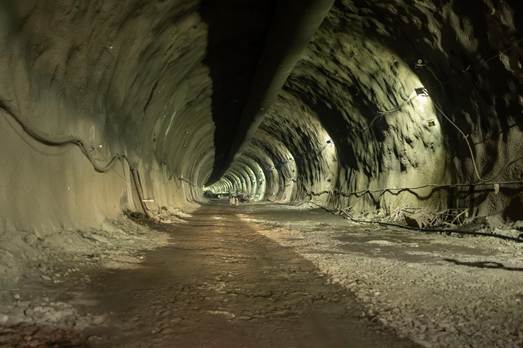Mumbai-Ahmedabad Bullet Train Project Achieves Undersea Tunnel and E10 Shinkansen
In a powerful display of India-Japan strategic and technological partnership, Japan has announced the introduction of its next-generation E10 Shinkansen trains for the MAHSR corridor.

- Country:
- India
India’s ambitious Mumbai-Ahmedabad High-Speed Rail (MAHSR) project, popularly known as the Bullet Train project, has crossed a landmark engineering milestone with the opening of the first section of the 21-kilometer undersea tunnel between Mumbai’s Bandra-Kurla Complex (BKC) and Thane. This development signals not only a technological triumph but also the maturity of India’s high-speed rail capabilities, facilitated through strategic collaboration with Japan.
The tunnel, a part of a larger 508-kilometer high-speed corridor, represents India's first underwater rail tunnel, a feat involving advanced boring and tunneling technology that blends marine and civil engineering ingenuity. Designed to withstand significant hydrostatic pressure and constructed deep beneath the Thane Creek, it reflects India’s rising capacity to deliver world-class, complex infrastructure projects.
Progress Across the Alignment: Viaducts, Stations, and Electrification in Full Swing
The project, being implemented by the National High-Speed Rail Corporation Limited (NHSRCL), has already completed 310 kilometers of viaduct construction, covering nearly two-thirds of the entire corridor. These elevated structures are a crucial part of the alignment, facilitating high-speed, uninterrupted transit across varied terrain.
Civil works have rapidly progressed across multiple fronts:
-
15 river bridges completed, with 4 more nearing completion
-
12 stations are under construction; 5 are already completed, and 3 more are in final stages
-
Track laying, station finishing, and electrical systems installation are proceeding in parallel
The BKC Station, in particular, is an engineering marvel, located 32.5 meters underground. Its foundation is uniquely designed to support a 95-meter high commercial building above it, merging transport infrastructure with future urban development.
Rolling Stock Upgrade: India to Launch with Japan’s Latest E10 Shinkansen
In a powerful display of India-Japan strategic and technological partnership, Japan has announced the introduction of its next-generation E10 Shinkansen trains for the MAHSR corridor. These trains represent a significant upgrade over the current E5 series, offering enhancements in speed, energy efficiency, passenger comfort, and safety.
What makes the announcement historic is that India and Japan will simultaneously deploy the E10 trains—a testament to the high level of trust and collaboration between the two nations.
The E10 series will operate at speeds up to 320 km/h, with capabilities to adjust dynamically for environmental conditions. The rolling stock will also feature state-of-the-art control systems, earthquake detection, and tilting technology, ensuring smoother rides even at high speeds.
Japanese Shinkansen Technology: Setting Global Benchmarks in India
The entire 508-km corridor is being developed using Shinkansen high-speed rail technology, globally recognized for its precision, reliability, and safety. From rolling stock to signaling systems, operational control, and track design, every aspect of the MAHSR corridor reflects the deep technological infusion provided by Japanese experts.
This makes the Mumbai-Ahmedabad Bullet Train not only the first high-speed rail corridor in India, but also one of the most advanced in the world, incorporating Japanese Seismic Safety Systems, Automatic Train Control, and dedicated elevated tracks that reduce friction and noise.
Momentum in Maharashtra: Construction Picks Up Speed
While early phases of the project saw quicker progress in Gujarat, Maharashtra has now picked up momentum. Tunnel boring activities, viaduct construction, and station development are now visible across Mumbai, Thane, and Palghar. Local sourcing and workforce engagement have increased, boosting regional employment and skill development.
With daily monitoring and inter-agency coordination, the Maharashtra segment is aligning quickly with the rest of the corridor, ensuring timely execution of India’s first bullet train project.
Strategic Impact: Foundation for Future High-Speed Rail Corridors
The MAHSR corridor is more than just a rail line—it is the foundation of India’s high-speed rail ecosystem. Its successful execution is expected to catalyze the development of other high-speed corridors currently under active planning, including:
-
Delhi–Varanasi
-
Delhi–Ahmedabad
-
Chennai–Mysuru
-
Mumbai–Nagpur
-
Hyderabad–Bengaluru
The model of technology transfer, joint procurement, and collaborative training with Japan serves as a template for future bullet train routes across India.
India-Japan Partnership: A Testament to Mutual Trust and Shared Vision
At every stage, the MAHSR project underscores the strength of the India-Japan partnership, rooted in mutual respect, shared technological goals, and a commitment to sustainable infrastructure. Japan’s continued support—from funding through the Japan International Cooperation Agency (JICA) to providing specialized technical teams—has been critical to the project's progress.
A Transformative Journey in Motion
With the opening of the undersea tunnel section and introduction of E10 Shinkansen trains, India’s Bullet Train dream is rapidly transforming into a tangible reality. The remarkable pace of development and cross-continental collaboration underscores a new era of high-speed mobility in India—one that promises faster, safer, and greener travel for millions.
As India prepares to launch its first high-speed passenger operations, the MAHSR corridor stands as a beacon of global engineering excellence, redefining the country’s transport future while strengthening ties with strategic partners.










